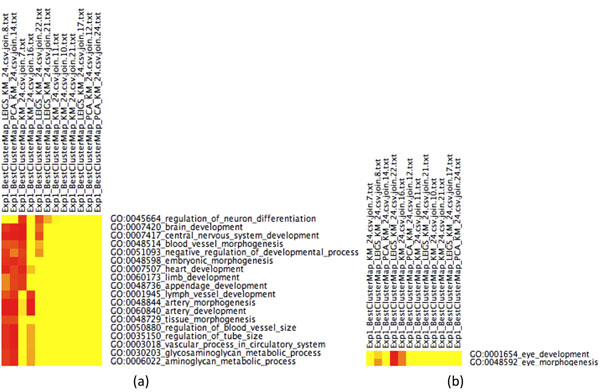Figure 3.
CIMs across methods Enriched GoMiner categories that are shared among clustering methods. Each of the 3 different clustering methods (LEIGS KM 24, PCA KM 24, KM 24) produced 24 clusters. We picked 12 among the 72 clusters that seemed to show significant enrichment by means of GO categories. (Yellow means no association. The darker red, the stronger the association between cluster and category) Cluster 22 from Laplacian Eigenmaps+k-means has shown eye related GO categories in Figures 1 and 2 with very stringent FDR. Figures 3 a)-b) verify that these categories have not been picked by chance and that the proposed Laplacian-based scheme leads to lower false discovery rates than the other methods and hence appears to provide greater biological specificity and sensitivity.
(a) GO categories that are shared by at least three clusters, FDR< 0.10. First, cluster 8 of Laplacian Eigenmaps+k-means appears to be closely related to cluster 14 derived from PCA+k-means. Cluster 22 from Laplacian Eigenmaps+k-means shares few biological functions with cluster 7 of k-means. However, GO categories that are related to eye development are not shared by any other method at FDR< 0.10. Recall that cluster 22 from Laplacian Eigenmaps+k-means has shown enrichment for these categories already at FDR< 0.05 in Figure 1.
(b) The portion CIM with FDR< 0.20 that is associated to additional eye development categories that weren’t present in Figure 3a). They are shared by the Laplacian+k-means cluster 22, by k-means cluster 16, and by Laplacian+k-means cluster 8. The entire CIM contains too many GO categories to be listed here.

